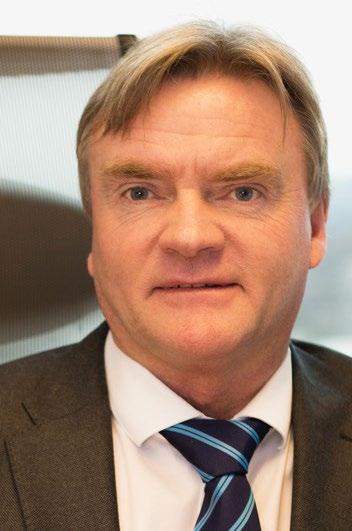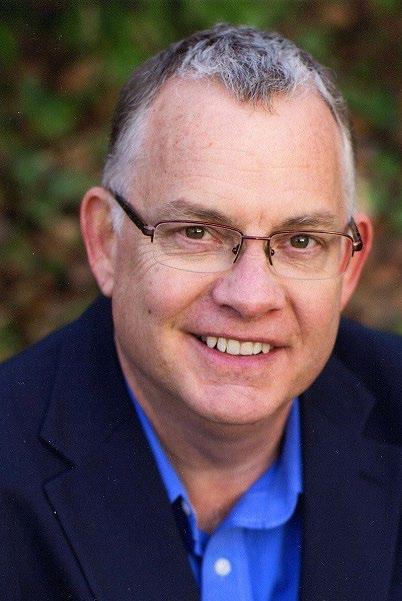
6 minute read
PROFILE
from CSI Summer 2021
by Maritime-AMC
United European Car Carriers is introducing greener ships as part of its journey to a greener logistics chain. Clean Shipping International finds out more...

Glenn Edvardsen, UECC CEO
USHERING IN A NEW ERA
The first of three LNG battery hybrid pure car truck carriers (PCTCs) to be owned by NYK and Wallenius’ short sea operator United European Car Carriers (UECC) was launched on 12 April at the Jiangnan Shipyard in Shanghai.
She will be delivered in October this year, while the other two vessels are scheduled to enter service in 2022.
“With the launch of our first LNG battery hybrid PCTC, we are ushering in a new era for UECC and short sea shipping in Europe,” claims Glenn Edvardsen, UECC CEO. “These ships prove that de-carbonisation of the industry is possible using currently available technologies.”
The new UECC PCTCs are being built to the latest energy efficiency criteria, meeting the Tier 3 IMO NOx emission limitations in place for Baltic and North Sea operations. All three will be equipped with battery hybrid systems that will enable UECC to far exceed the International Maritime Organization’s (IMO) target of 40% reduction in carbon intensity by 2030, the company claims.
“The introduction of batteries is an excellent demonstration of our deepening commitment to next-generation sustainability”, Edvardsen says.
Battery power fitted on the new vessels will improve operational efficiency and further reduce emissions through peak shaving, in addition to handling partial accommodation load and driving auxiliary equipment. “Battery power also provides an option for reducing emissions while in port, a feature that more and more cities are demanding,” he adds.
The ships are also equipped with dualfuel LNG main propulsion and auxiliaries. As more biofuels are set to become commercially available in the future, UECC plans to increase the percentage of carbon neutral and synthetic fuels in their future fuel mix. “We aim to be in front of the move to sustainability in shipping,” Edvardsen explains. “This is the motivation behind our decision to invest in dual-fuel solutions for these newbuildings.”
All three PCTCs will also be designed

An impression of the 3,600 unit hybrid PCTC design
to enable them to have cold ironing equipment fitted at a later date, following cold ironing trials in key ports on their schedule. In addition, they will be fitted with ballast water treatment plants, which are claimed to be ahead of the latest IMO requirements.
With a length overall of 169m, a width of 28m and a car carrying capacity of 3,600 units on 10 cargo decks, the new vessels are claimed to be highly flexible, enabling them to accommodate a wide range of high and heavy and breakbulk cargoes, in addition to cars and trucks.
“UECC’s parent companies, NYK and Wallenius Lines, have sustainability in their DNA,” Edvardsen continues. “We are proud to be able to take UECC to the next level of sustainable shipping with their support.”
In 2016, UECC became the first company to build larger scale LNGfuelled vessels, when it took delivery of the Auto Eco and Auto Energy and today has added the battery element to the fuel mix to further reduce emissions.
That year, one of the vessels completed a 14-day voyage running purely on LNG. She called at UECC’s regular ports of Southampton, Zeebrugge, Bremerhaven, Malmo, Hanko and St Petersburg.
This experiment proved that these larger capacity vessels had greater operational flexibility, giving less fuel consumption thus reducing emissions.
Edvardsen explains that UECC, backed by NYK, is attempting to find solutions for its older tonnage. But he admits that it was difficult to find a cost-effective sustainable solution. “It’s not a quick fix,” he says.
Both biodiesel and biogas are being looked into at present, he explains.
Last February, UECC concluded a 12-month trial period operating the 21year old car carrier Autosky on biofuel. During the trials, the 2,080-vehicle
capacity ship operated between Rotterdam, Zeebrugge, Santander and Pasajes.
UECC says it had bunkered over 6,000 tonnes of biofuel during the yearlong trial period, which was exclusively supplied by GoodFuels.
The biofuel contained a variety of feedstocks, including processed used cooking oil.
All of the biofuel consumed during the period was sustainably sourced using waste and residues with no higher quality application available.
UECC says that the switch to biofuels required little-to-no technical modifications to the vessel and the fuel was handled on board by expert engineers without any issue. Autosky’s fuel tanks underwent a deep clean and the crew were trained to handle the new fuel.
The company claims that the results of the experiment were striking: a reduction of more than 20m kg of CO2 emissions, an absolute reduction of more than 9,000k of SOx emissions and a similarly total reduction in Particulate Matter.
Putting it into context what this means for customers, UECC calculates the Autosky’s carbon intensity on a grams of CO2 per tonne/km basis: » 2018: 85.51 gCO2/tkm » 2019: 85.62 gCO2/tkm » 2020: 35.96 gCO2/tkm This gave a 58% reduction in carbon intensity.
The trials were originally intended to last for three months, but were extended to a year and today the vessel is continuing to operate on biofuels.
UECC has a timeline to reduce CO2 from its ships between 2016-2025 and hopes to meet the goals with the new vessels in co-operation with fuel provider GoodFuels and vehicle manufacturer BMW.
MASS BALANCE PRINCIPLE
Edvardsen calls the experiment the “mass balance principle” — taking advantage of subsidised biofuel already used in the fleet and assigning carbon reduction to the cargo (vehicles) carried. UECC has acquired certificates for the sustainably sourced biofuels, which effectively “greenwashed” the LNG used on board.
UECC purchases physical bioLNG, which is then transported to the vessels and is used when transporting a vehicle manufacturer’s cargo.
“We can burn other fuels in the LNG powered engines. There is a level of investment needed, so need the co-operation and partnership process around the contracting to reduce costs,” Edvardsen explains.
CLIMATE-NEUTRAL GOALS
At a recent presentation, Edvardsen was joined by Martin Corner, Volvo Cars Vice President of Global Supply Chain and Marc Andriansens, Managing Director of NYK subsidiary ICO Terminals.
ICO operates two car terminals, one at Zeebrugge (250 hectares) and the other at Antwerp (125 hectares), employing a total of 1,250 staff, including stevedores and handling 2.7m cars per year.
Corner said that Volvo’s goal was to become a climate neutral company by 2040 and the company was working hard on vehicle electrification. “In the logistics chain, there are no CO2-neutral solutions, so there is a need to create them,” he said.
As for the terminals served, there was need to strip out waste, such as the distance the cars need to travel to and from the vessels. Scalability +sustainability = affordability + lead time was the mantra.
Andriansens said that a greener operation would be achieved through digitalisation, adding that the supply chain can be made more efficient by the less movement of cars.
He explained that digitalisation in the logistics process means reducing the ecological footprint by creating a “greener” terminal. For example, the Zeebrugge terminal area boasts the largest wind farm in the Flanders region with 11 wind turbines fitted producing 110gw/h renewable energy per year or a loading capacity of 20,000 EV cars per week.
ICO has also fitted solar panels on its warehouses and uses LED lighting throughout the terminal. In addition, electric charging islands with 308 loading stations have been fitted.
In the building, heat pumps have been fitted for both heating and cooling purposes and a water recovery system has been built on the cash wash area. ICO only uses electric powered vehicles within the terminals.
Future developments include the provision of onshore power to the ships and the fitting of battery packs next to the berths powered by wind. To this end, a joint project is underway with UECC.

Auto Energy is one of two LNG-powered PCTCs built in China in 2016











